Hello there! Are you interested in starting a terrace garden or rooftop farm but need help deciding which vegetables to grow? Look no further! This article will introduce you to the top 10 vegetables perfect for terrace farming. These vegetables are easy to grow and contain essential nutrients that benefit your health.
Growing these vegetables in your terrace garden allows you to access fresh and healthy produce at your doorstep. Plus, you can take pride in the fact that you are contributing to a more sustainable and eco-friendly lifestyle. So, let’s explore the best top 10 vegetables for terrace garden/rooftop farming below.
What is Terrace Garden/Rooftop Farming?
Terrace gardening, known as rooftop farming, has become popular in urban areas due to limited space. The best season to start a terrace garden depends on the location and climate, and regular watering and fertilization are necessary for healthy plants and a good yield. It’s important to select the right type of plants for the available sunlight and climate. Terrace gardening is a great way to supplement your food supply, reduce your carbon footprint, and connect with nature while enjoying the benefits of fresh produce.
Need for Terrace / Roof Gardening
Terrace or roof gardening has become popular in urban areas due to limited space and the need to save money on buying vegetables from the market. Terrace gardening offers fresh and pesticide-free vegetables, helps harvest rainwater, keeps the building cooler, reduces stress, and keeps you close to nature. The setup cost for a terrace garden is low and varies depending on the size of your terrace, the type of plants you want to grow, and the materials used.
Benefits of Terrace Garden/Rooftop Farming
- Fresh and pesticide-free produce: Terrace gardening allows you to grow vegetables and fruits free from harmful pesticides and chemicals.
- Saves money: Growing your produce can save significant money on grocery bills.
- Eco-friendly: Terrace gardening is a sustainable and eco-friendly way of living. It reduces the carbon footprint by eliminating the need to transport vegetables from the farm to the market.
- Helps to reduce air pollution: By planting more trees and plants, terrace gardening helps to reduce air pollution and provide clean air.
- Aesthetically pleasing: Terrace gardens can add to the visual appeal of your home and provide a soothing environment for relaxation.
- Provides fresh oxygen: Plants release fresh oxygen, which is beneficial for health and helps to reduce stress levels.
- Utilizes unused space: Rooftops and terraces are often unused spaces that can be utilized for farming, thus maximizing available land.
- Promotes biodiversity: By growing different varieties of plants, terrace gardening promotes biodiversity, which is essential for a healthy ecosystem.
- Reduces urban heat island effect: Terrace gardening helps to reduce the urban heat island effect, where urban areas experience higher temperatures than the surrounding rural areas.
- Water conservation: Terrace gardening helps to conserve water by harvesting rainwater and using it for irrigation.
Importance of Choosing the Right Vegetables
- Climate suitability: Choosing well-suited vegetables for the local climate can ensure they thrive and yield a good yield.
- Space availability: Terrace gardens have limited space, so choosing vegetables that only require a little space to grow is important.
- Seasonal suitability: Choosing vegetables for the current season can ensure they grow and yield well.
- Time to harvest: Some vegetables take longer to mature than others. Choosing vegetables that have a shorter time to harvest can ensure that you have a continuous supply of fresh produce.
- Nutritional value: Choosing vegetables rich in nutrients is important to ensure a healthy and balanced diet.
- Pest resistance: Some vegetables are more resistant to pests and diseases than others. Choosing pest-resistant vegetables can reduce the need for pesticides and chemicals.
- Yield potential: Choosing vegetables with a high yield potential can ensure that you have enough produce to meet your needs and even sell the excess.
Best Top 10 Vegetables for Terrace Garden/Rooftop Farming
These vegetables are not only easy to grow, but they are also nutritious and delicious. Growing these vegetables in your terrace garden allows you to enjoy fresh and healthy produce at your doorstep.
Tomato
Tomato plants are fruiting vines with bright red, juicy fruit high in nutrients such as vitamin C and lycopene. They require full sun and well-drained soil.
Best Varieties for Terrace Farming
- Cherry tomatoes, such as Sweet 100 or Sungold, are great for small spaces.
- Patios or determinate varieties, such as Celebrity or Roma, are also good choices.
- Heirloom varieties like Brandywine or Cherokee Purple are popular for flavor and can be grown in containers.
In case you missed it: Nutritional Deficiencies in Tomato Crop: How to Fix, Solutions, and Treatment
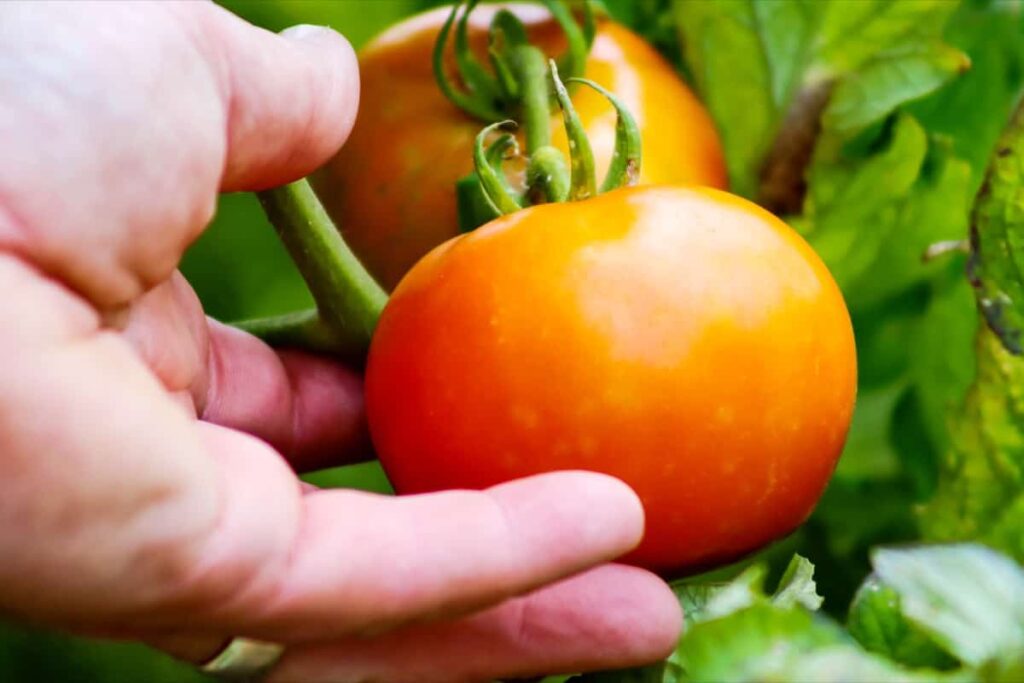
Planting and Care Tips
- Choose a large container or grow bag with good drainage.
- Use a high-quality potting mix and add fertilizer.
- Water regularly and consistently, but avoid overwatering.
- Provide support for the tomato plant, such as a cage or trellis.
- Prune the plant as needed to control its size and promote air circulation.
Health Benefits and Culinary Uses
- Tomatoes are high in vitamins A and C, as well as lycopene, which is an antioxidant that may help prevent cancer.
- They are versatile in the kitchen and can be used in various dishes, from salads to sauces.
- Tomatoes can also be dried, canned, or made into salsa or ketchup.
Cucumber
Cucumber is a creeping vine plant that belongs to the gourd family. It produces elongated, cylindrical fruits with tough, dark green skin and crunchy, juicy flesh.
Best Varieties for Terrace Farming
- Bush pickle: Compact plant with a high yield of small cucumbers that grow well in containers.
- Salad bush: Compact plant with a high yield of crunchy cucumbers perfect for salads.
- Patio snacker: Short vines that grow well in small spaces and produce sweet and crispy cucumbers.
In case you missed it: How to Grow Cucumber Plants Faster: Best Tips to Increase Flowering, Fruiting, and Production Yield
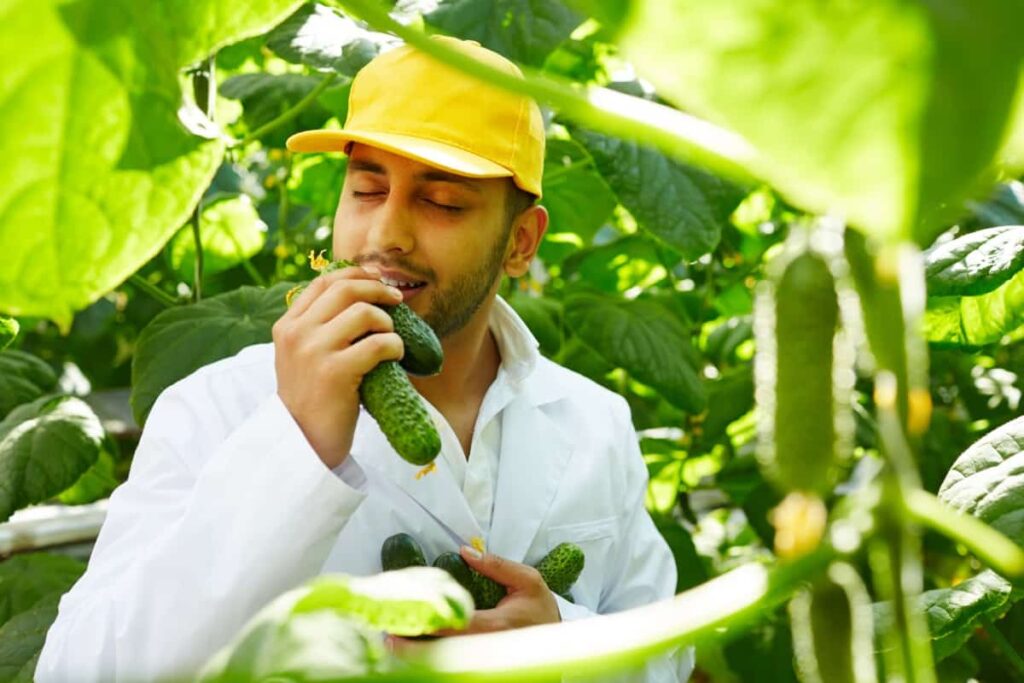
Best Planting and Care Tips
- Soil pH: Cucumbers prefer a slightly acidic pH of 6.0 to 6.8.
- Pest management: Check for common pests like cucumber beetles and aphids, and treat them with insecticidal soap or neem oil.
- Watering: Cucumbers need consistent moisture, so water deeply and regularly, especially during dry spells.
- Harvesting: Pick cucumbers when they are firm and about 6 to 8 inches long.
Health Benefits and Culinary Uses
- Cucumbers are low in calories and water content, making them a great addition to a healthy diet.
- They contain vitamins C and K and antioxidants that may help reduce inflammation and improve digestion.
- Cucumbers are commonly used in salads, sandwiches, and pickles and can also be blended into refreshing drinks like cucumber lemonade or smoothies.
Eggplant/ Brinjal
Eggplant, or Brinjal, is a popular vegetable grown on the terrace or rooftop farming.
Best Varieties for Terrace Farming
- Dwarf varieties like ‘Black Beauty’ or ‘Hansel’ work well in smaller spaces.
- Compact varieties like ‘Fairy Tale’ or ‘Little Fingers’ are good for container gardening.
- Heirloom varieties like ‘Listada de Gandia’ or ‘Rosa Bianca’ have unique flavor profiles.
Best Planting and Care Tips
- Soil pH should be between 5.5 and 6.5.
- Plant seeds or seedlings in well-draining soil with mixed compost or aged manure.
- Keep soil consistently moist but not waterlogged.
- Control pests like flea beetles and aphids with insecticidal soap or neem oil.
- Pinch off any flowers or fruit for the first few weeks to encourage root growth.
In case you missed it: Profitable Organic Eggplant/Brinjal Cultivation in West Bengal: A Production Guide for Beginners
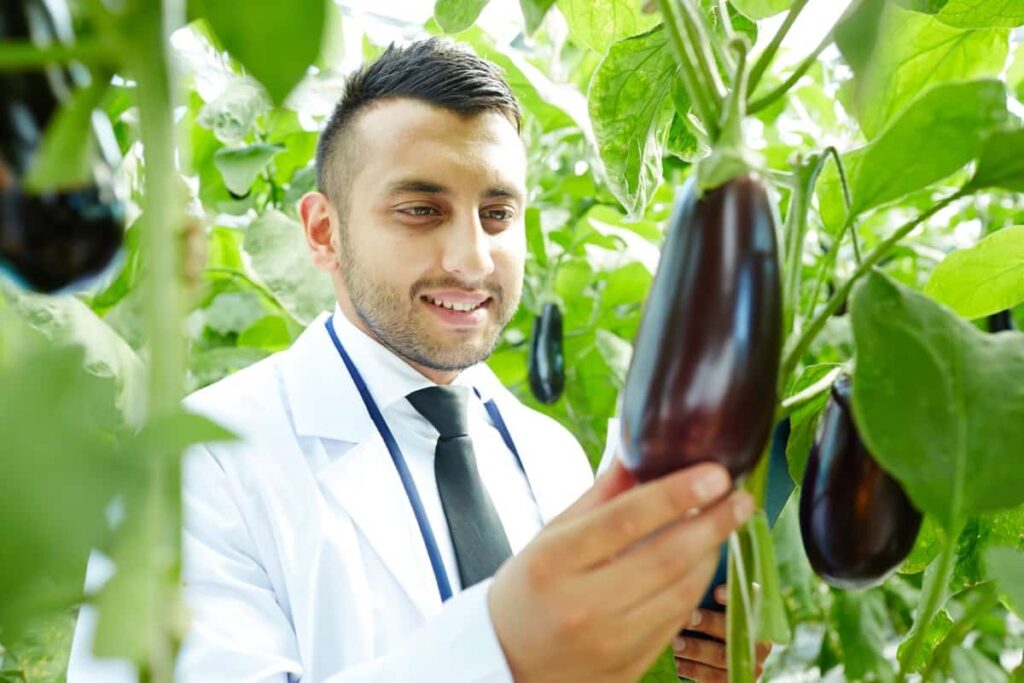
Health Benefits and Culinary Uses
- Eggplant is a good source of fiber, vitamins, and minerals.
- It can be roasted, grilled, or used in stews and curries.
- Eggplant is a common ingredient in Mediterranean and Middle Eastern cuisine and is often used in dishes like Baba Ghanoush and Moussaka.
Chili
Chili plants are pepper plant that produces spicy fruits commonly used for culinary purposes.
Best Varieties for Terrace Farming
- Thai chili: Small and spicy, perfect for Asian dishes
- Cayenne pepper: Spicier than Thai Chili, great for Mexican and Indian dishes
- Jalapeno: Mildly spicy, perfect for making salsa and guacamole
- Anaheim pepper: Mildly spicy, great for stuffing and grilling
- Habanero pepper: Very spicy, perfect for adding heat to sauces and marinades
Best Planting and Care Tips
- Choose a sunny spot on your terrace and ensure the soil is well-drained.
- The ideal pH level for chili plants is between 6.0 and 6.5.
- Water your chili plants regularly, but be careful not to overwater them.
- Use organic fertilizer to feed your plants.
- Protect your plants from pests using natural pest control methods like neem oil.
In case you missed it: Guntur Red Chilli Farming Project Report: Production Cost, Market Analysis, and Cultivation Practices
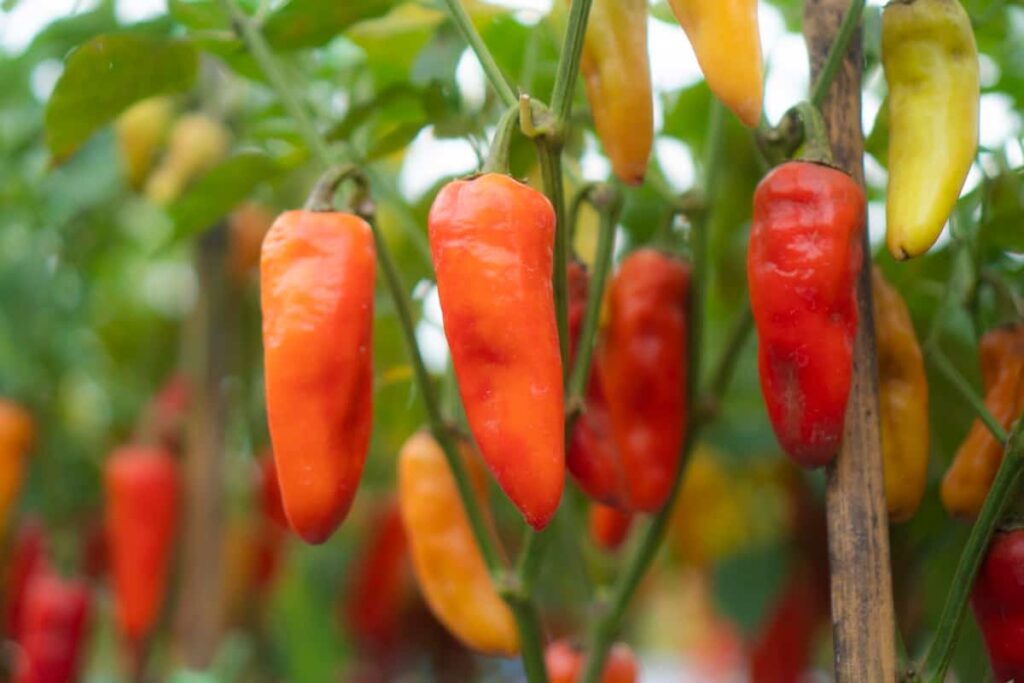
Health Benefits and Culinary Uses
- Chili peppers are high in vitamin C, which supports a healthy immune system.
- They can also help reduce inflammation and improve digestion.
- Culinary uses of chili peppers include adding spice to sauces, marinades, soups, and stews. They can also make hot sauce, salsa, and chili powder.
Potato
Potatoes are a starchy, underground tuber that belongs to the nightshade family. They are one of the world’s most widely grown and consumed crops and are a good source of carbohydrates and vitamins.
Best Varieties for Terrace Farming
- Yukon Gold: These potatoes are easy to grow and have a delicious buttery flavor.
- Red Pontiac: This variety is disease-resistant and produces high yields.
- Russet: These potatoes are perfect for baking and have a long shelf life.
- Fingerling: These small, elongated potatoes have a nutty flavor and are great for roasting.
Best Planting and Care Tips
- Soil pH: Potatoes grow well in slightly acidic soil, between 5.0 and 6.0.
- Pest management: Potato plants can be attacked by pests such as potato beetles and aphids. Regularly inspecting and removing affected plants or using organic pest control measures like neem oil or diatomaceous earth can help.
- Watering: Potatoes need consistent moisture but not overly waterlogged soil. It’s important to avoid waterlogging, which can cause the rotting of the potato crop.
- Fertilization: Potatoes need many nutrients to grow well, especially potassium. Composting is a great way to provide nutrients to your potatoes.
- Harvesting: Once the plants have died, wait two weeks before harvesting. This allows the potatoes to develop a thicker skin, making them last longer in storage.
Coriander
Coriander is an aromatic herb that is commonly used in cooking. It’s easy to grow and can be a great addition to your terrace or rooftop garden.
Best Varieties for Terrace Farming
- Slow bolt coriander
- Santo coriander
- Leisure coriander
Best Planting and Care Tips
- Soil pH: Coriander grows best in well-draining soil between 6.0 and 7.0.
- Planting: Plant seeds ¼ to ½ inch deep in rows or containers, and space them about 6 inches apart.
- Watering: Water regularly, but don’t overwater. Coriander prefers moist soil but can’t tolerate waterlogged conditions.
- Fertilizer: Use a balanced fertilizer/manure once a month to keep the plants healthy.
- Pest management: Watch out for aphids, spider mites, and leaf miners. To manage these pests, use organic pest control methods like neem oil or insecticidal soap.
- Harvesting: Coriander leaves can be harvested at about 4-6 inches tall. Use scissors to cut the leaves just above the soil line.
In case you missed it: Growing Coriander Organically in Madhya Pradesh: Cultivation and Production Management
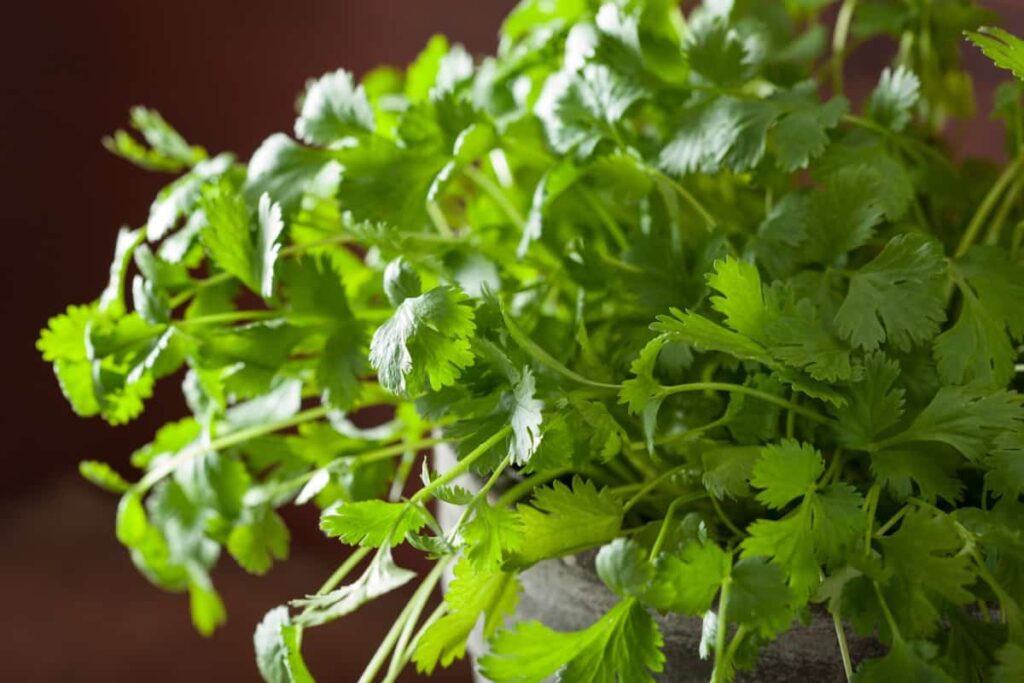
Capsicum
Capsicum plants are also known as sweet, bell, or chili peppers. They are a warm-season crop that grows best in temperatures between 20-25°C. Capsicum plants have shallow roots and require well-drained soil.
Best Varieties for Terrace Farming
- California Wonder
- Yolo Wonder
- Early Pimento
Best Planting and Care Tips
- Choose a location that is full of sunlight and has well-draining soil.
- The soil pH should be between 6.0-6.8.
- Capsicum plants require regular watering, but the soil should not be waterlogged.
- Fertilize the soil before planting with organic manure or compost.
- Protect the plants from pest attacks by using neem oil or organic insecticides.
- Prune the plants regularly to promote growth and improve air circulation.
- Harvest the capsicum when it reaches its mature size and color.
In case you missed it: How to Grow Jalapeno Peppers from Seed: A Step-by-Step Guide for Types, Seed Germination, and Planting
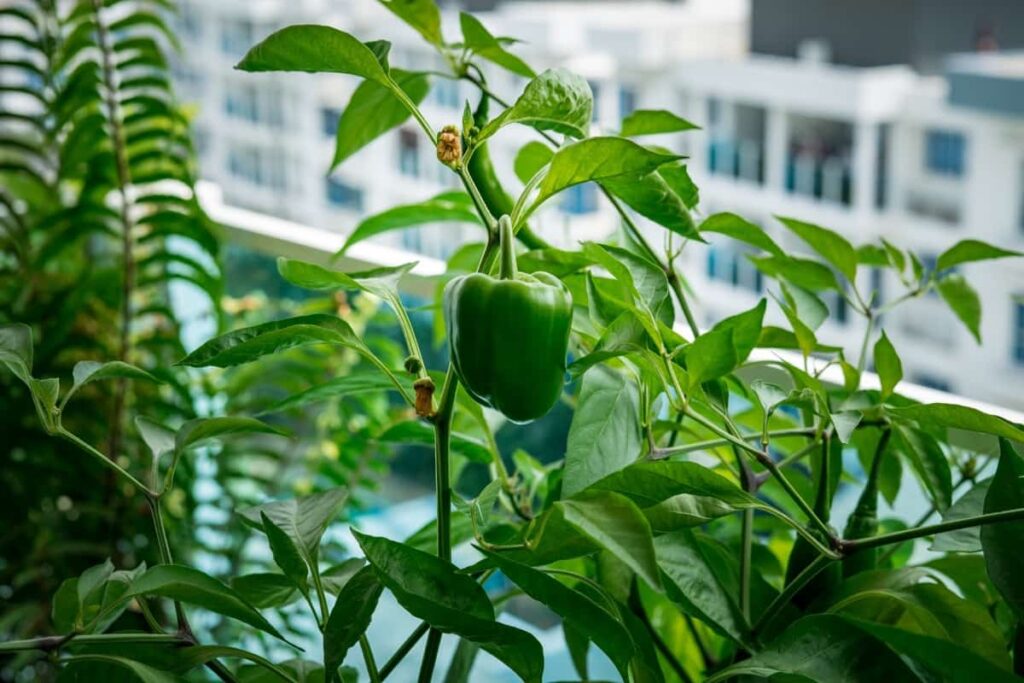
Okra
Okra is a warm-season vegetable easy to grow in terrace farming or rooftop gardening. Okra plant is a tall-growing plant with edible green pods used in various dishes, such as stews, curries, and soups.
Best Varieties for Terrace Farming
- Clemson Spineless: This is the most popular variety for terrace farming, with smooth and tender pods 4-5 inches long.
- Emerald: This is another great variety for terrace farming, with dark green pods that are 6-8 inches long.
Best Planting and Care Tips
- Soil pH: Okra plants prefer slightly acidic soil with a 6.0-6.5.
- Planting: Plant Okra seeds directly in the soil or transplant seedlings when they are about 3-4 inches tall.
- Watering: Water regularly and deeply, ensuring the soil stays moist but not waterlogged.
- Fertilizing: Use a balanced fertilizer every two weeks to promote healthy growth.
- Pest management: Look for aphids and spider mites, and use organic insecticides if necessary.
- Harvesting: Harvest Okra pods when they are 3-4 inches long, and pick them regularly to encourage more growth.
Spinach
Spinach is a leafy green vegetable easy to grow on the terrace or rooftop farming. Spinach is a leafy green plant that grows well in cooler weather. It is a slightly sweet taste and is rich in vitamins and minerals. Best varieties for terrace farming: Baby Leaf, Bloomsdale, New Zealand
Best Planting and Care Tips
- Soil: Spinach grows best in well-draining soil with a pH range of 6.0-7.5.
- Planting: Spinach can be planted in early spring or fall. Plant seeds 1/2 inch deep and 2-3 inches apart.
- Watering: Spinach needs consistent moisture, so water regularly and mulch to retain moisture.
- Pest management: Spinach can be susceptible to pests like aphids and leaf miners. To manage pests, use organic pest control methods, like neem oil or insecticidal soap.
- Harvesting: Spinach leaves can be harvested when they are 2-3 inches long. Cut leaves from the plant with scissors and leave the crown intact for regrowth.
Beans
Beans are a legume plant that produces pods filled with edible and nutritious seeds. Beans are a popular and easy-to-grow crop for terrace or rooftop farming.
Best Varieties
- Bush beans
- Pole beans
- French beans
Planting Tips
- Plant beans in well-draining soil with a pH of 6.0 to 7.0.
- Sow seeds directly into containers or beds at a depth of 1-2 inches.
- Water regularly and keep the soil moist.
- Fertilize every 1-3 weeks with a balanced fertilizer.
- Control pest attacks using organic pest management techniques, like neem oil or companion planting.
- Harvest beans when the pods are plump and crisp.
Conclusion
Terrace farming is a great way to grow fresh and healthy vegetables, even with limited space. You can create a productive garden on your terrace by choosing the right vegetables and following some simple tips. With the top 10 vegetables for terrace farming, you can enjoy a bountiful harvest all year round.
- Profitable Village Farming Business Ideas in 2024
- High-Yield Aquaculture: Fast-Growing Fish for Farming
- Effective Fish Pond Construction Techniques for Beginners
- Irrigation and Water Management in Pineapple Farming
- Blossom to Harvest: Mastering Flowering and Pollination in Papaya Farming
- Pig Fattening Essentials: From Selection to Sale for Beginners
- Raising Wagyu Cattle: A Complete Guide for Premium Beef Production
- Soil Types and Their Water Holding Capacity
- Optimizing Irrigation Schedules for Coconut Groves for Enhanced Yield
